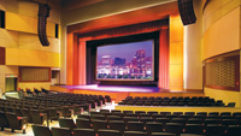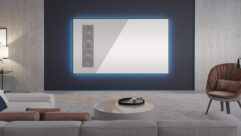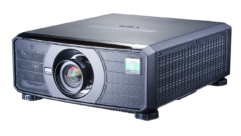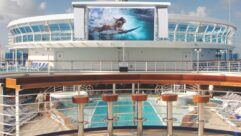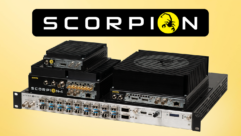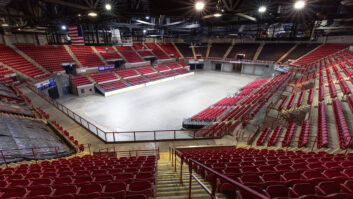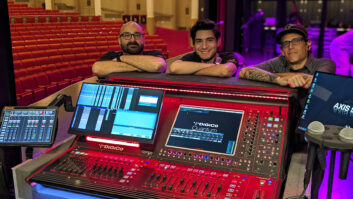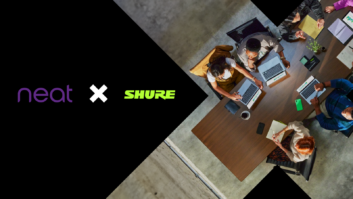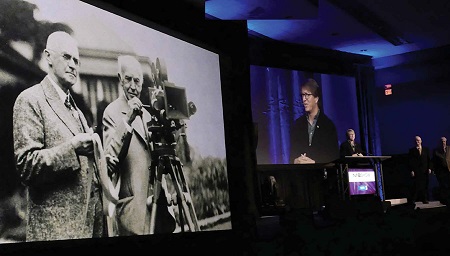

The Cinema Summit, organized by SMPTE and NAB and held each year in Las Vegas the weekend right before the opening of the show floor at NAB, is perhaps the best place to examine the nation’s most iconic pillar of the entertainment industry. The best thing about the Summit? On the surface, it looks like a laid-back affair. Studio execs mingle with engineers, production people, and hardware and software providers—outside the realm of the big PR machines and away from the hype of either Hollywood or the mass media. And the Cinema Summit is kind of sandwiched in between the folds of more high profile events—the Oscars, the NAB show itself (that’s more about the television industry), CinemaCon (where the movie theater owners meet, that always bumps up against the Cinema Summit), and a variety of smaller conferences in L.A. and New York. So in that quiet back lot of sorts, on the eve of NAB, the big players were at the Summit, but relaxed and in a mood to talk about what the big studios have always been about: technology. New technology. Disrupted technology. Technology that will circle the wagons against TV, or VOD, or whatever else they will throw our way, and save big screen cinema (again). And give the rest of the market for high-lumen projection a needed boost as well.
And right on the heels of the Cinema Summit, the important CinemaCon took place also in Las Vegas, the week of April 20th, and the big high-lumen projector/cinema projector manufacturers made good on their Cinema Summit promises—with more detail on big gun projectors, and a few surprises on the mix between full-blown laser, laser phosphor, and even some new flavors of xenon lamp projection.
Feature

The xenon projector is very much alive and prospering—as laser projection at very high lumen is still expensive and not fully out there. All the big projector manufacturers are releasing new-gen xenon lamp high-lumen projectors that max out the technology and take it to new levels. Making its North America debut at NAB was the Christie Boxer 4K 30K Lumen, shown here at the Christie booth at NAB. Delivering “unrivaled brightness for its size and weight,” according to Christie, the Boxer 4K30 is a projector designed for high-impact rental staging and large venue events. Weighing 150lbs., Christie Boxer is, says Christie, “the brightest, lightest and smallest 30,000 lumen projector in its class.” With 4K and enhanced HD upscaling, and “More than double the life of xenon lamps.”
e Cinema Summit featured seminars and panels on other important issues that have popped up in the wake of the analog to digital transition (lack of archiving standards for digital; audio not just video issues; HDR) but there is near-unanimous agreement in Hollywood that the most important issue is: if they don’t get the wow factor unequivocally, measurably back on the big screen, the other issues will be moot.
In 2014, box office sales were down in the U.S.—down from $10.92 billion in 2013 to $10.36 billion for 2014, but when you factor in rising ticket prices, the decline in attendance/seats sold is more dramatic. And more troubling, given that the Hollywood studios and NATO (National Association of Theater Owners) members invested heavily in 3D production and exhibition over the past 10 years, is that since the post-Avatar peak in 2010, 3D box office revenues have been declining each year. 2010 saw the peak in North America 3D box office revenue at $2.2 billion; 2011-2013 saw a three-year run of $1.8 billion annually; and 2014 saw a steep decline to $1.4 billion. This dive of 3D revenue in North America has all players scrambling to find the new new thing for the cinema experience. And as Cinema Summit presenter Michael Karagosian pointed out in the session on new projection screen developments, 57 percent of the world’s movie screens are 3D. (Industry lore—impossible to confirm—says that by Chinese law or at least de facto policy, new movie theater installations in that country must be 3D. Confirmation or not, you can easily do the math on the importance of 3D for a cinema market whose growth is internationally driven.)

NEC Display Solutions of America, announced at CinemaCon, the latest addition to its digital cinema laser projector lineup, the NC1201L Digital Cinema Projector, targeted to theaters with smaller screens, which will be available in the Fall of 2015. As part of NEC’s Digital Cinema Projector Series, the NC1201L projector provides 14 ft. L (using a 1.8 gain screen) on screens up to 39.4 ft./12m in DCI color (about 12,000 lumens). NEC also has two new laser phosphor projectors in its pro AV lineup—the NEC PH1201QL projector delivers a native 4K (4096×2160) resolution, while the NEC PH1202HL model delivers full HD 1080p as its native resolution. The 3-chip DLP laser projectors each emit 12,000 lumens of brightness, and maintain 2000:1 and 10,000:1 contrast ratios, respectively. The lamp-less projectors use blue laser with yellow phosphor as their light sources and emit consistent light output over their lifetimes. That means mercury-free components, no more lamp replacements, and 20,000 hours of projector life at maximum brightness.
At the 2014 Cinema Summit, these trends were already being recognized, and the race among the big technology providers to find a solution was heating up—with the showing of laser light source projectors. But with all the talk—and demos from Barco, Christie, and NEC last year—of the potential of the new laser technology, the key word last year was “potential.” The projector manufacturers were jockeying for future position with different laser platforms. Christie behind a two-projector, laser illumination offering for 3D; Barco with a one-projector 3D solution; and NEC with a laser phosphor projector aimed at smaller screens needing less lumens than what Barco and Christie were gunning for. There was a great deal of argument over which laser system was best for 3D, and dueling engineers talked about heating/cooling and a variety of engineering issues—all with one goal in mind: get more lumens on the screen.
The laser projector demos were impressive last year, but there was a general feeling that NATO members were still bruised and beat up a little from having invested a lot in conventional 3D and some of them HFR on top of that, and that it would be a hard sell to try to push another “upgrade” in projection technology on them.
What a difference a year makes. At the Cinema Summit, the landscape had changed. Laser projection was no longer an intriguing option out on the horizon. The race is on now, and the big players are making alliances, making sales, and firing salvos not with PowerPoint presentations but with real product.
At this year’s Cinema Summit, Christie did not participate in demos, ostensibly because they were keeping their powder dry for the CinemaCon. (Sony, which has also demo’d projectors at past Cinema Summits, also did not have a presence in the agenda at this year’s event.) But Christie’s absence in the official agenda at Cinema Summit 2015 does not mean that Christie is not big on scene with laser projectors.

It would not be the Cinema Summit if we did not get a good look at some great images up on a big screen. Barco’s Goran Stojmenovik demo’d the company’s new Laser projector by showing clips from Dawn of the Planet of the Apes. Barco places all the RGB lasers inside the projector, in a single projector 6P 3D design that delivers up to 56K lumens to the screen. (“6P” is a 6-Primaray design: Laser projection with two sets of R, G and B primaries (R1G1B1 for left eye, R2G2B2 for right eye.)
Last December, Christie and Dolby Laboratories announced that Christie would co-develop, supply, install, and service Dolby Vision projection systems for “Dolby Cinema,” a branded premium cinema offering for exhibitors and moviegoers that delivers “the total cinema experience,” according to Dolby. The JT Eindhoven cineplex in the Netherlands opened in December 2014, the first Dolby Cinema locations to install a “Dolby Vision” projection system supplied by Christie. In the system, the projector is comprised of two projector heads—keeping with the two-projector, sequential left-right eye 3D system that Christie has been showing since NAB 2014. In addition to the visual element, Dolby is also using this new platform to help solidify its Atmos audio that it introduced in April 2012. Indeed, now that the Cinema Summit is wrapped, all cinema industry eyes are on CinemaCon 2015, coming fast on the heels of NAB, with the expectation that Dolby will use its footprint in the market, its new alliance with Christie, and its formidable PR machine to shake things up in the movie exhibition world.
Speaking of alliances—the other big alliance that will square off against the new Dolby-Christie camp is the Barco-IMAX team. Probably the most interesting part of the laser projection landscape over the past two years was IMAX’s plan to use laser projection to replace IMAX theaters’ legacy 1570 film projectors. When IMAX bought the Kodak 3D patents some years back, they were perceived as lighting out on their own, with their own exclusive, digital 3D two-projector/polarizing filter regime, that was kept under wraps, shown in private demos, and kept behind curtains in anticipation of a 2015 rollout. And indeed, IMAX showcased its new laser projection system April 1 at Universal’s Furious 7 global premiere at the TCL Chinese Theatre in Los Angeles. The Chinese Theatre, one of the largest IMAX theaters in the world, is one of more than a dozen locations that IMAX expects to outfit with laser projection this year. (IMAX has 830 theaters worldwide.)

At the session “New Developments in Cinema Screen Technology” at the Cinema Summit at NAB, Michael Karagosian (shown here), President of MKPE Consulting and one of the world’s top cinema technology experts, and Keith Watanabe, Director of Business Development, Cinema Equipment & Supplies, explored how screen technology is the most overlooked technology in the cinema– even though the technology of screen coatings, which define screen gain and perforation pitch, are becoming more important as the emphasis on resolution, 3D brightness, and HDR grows, and how real performance of a screen may differ significantly from idealized performance, dependent on several factors. Karagosian pointed out that polarized 3D is popular worldwide, for cinemas, so gain matters, and getting to the 7 Ft-L (DCI 3D) you need an efficient 3D projection system. Putting a gain control coating on a substrate is not as easy as it sounds and it comes down to– you have to be able to ship the screen and the coatings have to survive shipping.
The road to that rollout was a long and circuitous one. It started with IMAX making an early investment in the company Laser Light Engines. It then acquired the Laser/3D IP from Kodak. But as of last year’s Cinema Summit, David Keighley, Executive VP of IMAX, on Michael Karagosian’s panel “The Future of Cinema,” offered no hints about the final format of the coming IMAX laser projectors. Then, in a somewhat surprising twist in summer 2014, on the eve of InfoComm, Barco announced that laser veteran Bill Beck had joined Barco’s projection development and marketing efforts. Fast forward to late 2014, and this month’s IMAX debut of laser in L.A., and IMAX has solidified its relationship with Barco. The new IMAX unit used at the TCL Chinese Theatre marries an IMAX system with a Barco laser engine.
But it would be a mistake for any reader to assume that the biggest players—in terms of influence and trend-setting—in the cinema projection industry (Barco, Christie, and IMAX), are now paired off into two camps, the Dolby/Christie camp and the Barco/IMAX camp. Christie does not have all its chips in one market. Christie is well positioned to market large-venue laser projectors in applications not cinema-related: event staging (big concerts, corporate meetings, etc), theme parks, simulation, and more. For the cinema market, Barco is less married to IMAX, than just in a significant relationship. The IMAX market is the IMAX market, prestigious but not huge, and there are tens of thousands of regular commercial movie screens for which Barco can market its own branded laser projectors. And indeed, there were announcements from Barco at CinemaCon about more ranges of cinema laser projectors including a completely new line for them, for smaller cinema screens—laser phosphor projectors. Barco showed a developmental 18,000 lumen laser phoshor retrofit setup, in addition to four models of full laser projectors, the DP4K-60L, DP4K-45L, DP4K-30L, and DP4K-22L. (The DP4K-45L and DP4K-60L are already shipping, while the DP4K-22L and DP4K-30L will be shipping in Q4 2015.) Dolby will be interesting to watch. Dolby has said that delivering HDR (High Dynamic Range) to the home will be easier and more important than doing 4K.

Barco showed a developmental 18,000 lumen laser phoshor retrofit setup at CinemaCon, but for large-screen cinema and even non-cinema large venue projection, Barco has four models of full laser projectors, the DP4K-60L (shown here), DP4K-45L, DP4K-30L, and DP4K-22L. (The DP4K-45L and DP4K- 60L are already shipping, while the DP4K-22L and DP4K-30L will be shipping in Q4 2015.)
Dolby will be demo’ing HDR offerings at NAB with their Dolby Vision. Dolby has already announced plans for Amazon, as well as Netflix and others to provide “Dolby Vision” content “when Dolby Vision-supported TVs are available.” Does any of this sound familiar? An elaborate commercial movie theater/home theater master plan. I’m sure the former TI folks at Dolby, as the well as the former TI folks at other companies, will be keenly watching whether Dolby can do the very difficult: establish branding in the movie theater, and then leverage that branding to get consumers to double down on that in their living rooms. It’s nice if you can do it, but it’s trying to get the tail to wag the dog in today’s world where consumer technology is at the top of the branding/marketing pyramid, not the bottom.
And there are other players. Sony still has some cinema (albeit not growing) market share, and at the Cinema Summit this observer thought, “Well, it would only takes one product launch for them to get back in the game, now that the game is changing to laser. “ At CinemaCon, Sony in fact did make an announcement of a new cinema projector offering. But it was not a laser projector. The Sony system announced was the “SRX-R515DS” that combines two Sony SRX-R515 projectors to deliver a 30,000 lumen total output—really just double-stacking.
NEC has been more content to go after the smaller screens in cinemas. In fact, last year, NEC launched a laser projector that is very different that Barco’s and Christie’s bigger guns—an attempt by NEC to come in under the FDA’s regulatory radar, with a product that, because its less lumen output, attracts less FDA regulation. And at CinemaCon, NEC announced a new unit in its Digital Cinema Projector Series, the NC1201L projector, that provides 14ft. L (using a 1.8 gain screen) on screens up to 39.4ft./12 meters in DCI color—that translates to about 12,000 lumens.
As the dust settles on both the Cinema Summit, and CinemaCon, the high-lumen projection landscape is changing quickly. And not just for movie theaters. It’s obvious that with all the new laser projectors, laser phosphor projectors, and other technology developments, the cinema market may be leading the way but the technology is rapidly disseminating out to the staging market—for both entertainment and corporate events and theme parks. Greg Kadorian, director, Walt Disney Imagineering, who spoke at the “Non-Theatrical Presentation Using Digital Cinema Technology” session at the Cinema Summit, said that laser projection is coming to Disney theme parks this spring. Christie has shipped more high-lumen laser projectors than any other player, but the new-gen laser-phosphor projectors from a variety of manufacturers could change the landscape this year.


